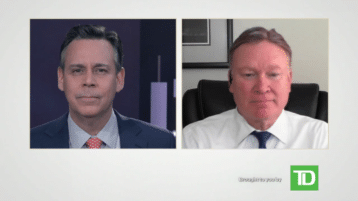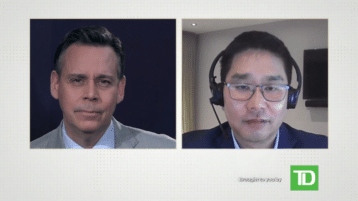In the last of our two part series, Anthony Okolie speaks with Hiren Amin, Client Education Instructor with TD Direct Investing, about what investors should know before they begin trading options. TD Direct Investing is holding an Options Month in June. Register at www.td.com/OEM.
[MUSIC PLAYING]
- With DI's education month kicking off in June, we're concluding the second of our two-part series on options trading. And joining us today is a Amin Hiren. He's a client education instructor at TD Direct Investing to discuss how to begin trading options. Hiren, what are the first things investors should do before getting into options trading?
- Tony, first thing I would say when you start with options trading is to really know what options are. Options are contracts which allow you to buy or sell an investment-- and, commonly, that will be a stock or an ETF-- up until a certain date in the future at a fixed price. Now, options could be rewarding, but also understand that there may be a higher degree of risk with trading options when compared to trading securities, like stocks and ETFs.
And in fact, to be able to get into option trading, that is actually a requirement. You have to have a precursory knowledge of and experience in trading stocks and ETFs. In fact, it's almost-- it goes complementary with trading stocks and ETFs.
The other thing that I would also say is, do your research and educate yourself. Education, education, education. Now, this might sound like a cliche statement. It's been said a lot. But we cannot stress this enough.
There's so many times that I've heard by various options-- people interested in options, perhaps-- that come with a perception where it's dangerous, or it's too risky. It's too complex for me. It's just, I'm scared of them. And we often fear of the unknown. But once you find that you educate yourself, that intimidation, it'll go away, basically, dissipate, and it'll be less daunting when you get into it. So, spend the time to educate yourself and understand how what options are, how they work, and the rules behind them.
- Absolutely. Education is important. Can you give us a simple example of what a call option is?
- Yeah, absolutely. So, a call option allows the buyer the ability to purchase the underlying security-- in other words, a stock or an ETF-- at a fixed price by a certain date. Let's talk about Mother's Day, if you will.
So, Mother's Day had just passed. It was just around the corner. And if you're like me, you would have been scrambling at the 12th hour looking for a bouquet of flowers for mom, and having to probably spend a pretty penny for them. But what if you could avoid this constant cycle of having to pay this through the use of a call option?
Well, what if we were to just wind back time, and maybe let's take it three months before Mother's Today is approaching. We go to a local florist and tell them, hey, I'd like to get into a call option with you. And what I want to do is I want the ability to buy this particular bouquet of flowers that you currently have at $30, just at this price, anywhere from now right up until Mother's Day.
And for this, I'm willing to give you $10. And this $10 is kind of non-refundable. Whether I end up buying those flowers or not from my florist, they get to keep that $10. The florist says, this is not a bad deal. I ordinarily sell them for 30 anyways. So an extra 10, that's just a profit for me. So, they agree to it.
Now, let's fast forward, and we're now just around Mother's Day. And now I remembered, oh, I got to get flowers again. And that worry set into me again, thinking I have to spend, and then I remembered that I have my call options. I go to my florist and I tell them, hey, remember we have this call option that we got into? And they say yes. And I say, well, here's $30. I would actually like to go ahead and purchase those flowers.
Now, meanwhile, everyone else is having to pay $50 for those bouquet of flowers. So, as you can imagine, we get to buy ours for $30. Now, we ended up also giving the $10 at the non-refundable deposit, so that ends up costing us a total of 40, which is still better than having to pay the market price of $50 that everyone else was paying.
I go up to Mom. Mom is happy. And, of course, I'm doing my little shimmy dance because I didn't have to turn my pockets inside out for those bouquet of flowers. And that is a call option.
- Thank you, that's a really good example. When it comes time to begin trading, what would you suggest is a good option strategy to start with?
- So, in the options world, there are a number of different strategies that you have a choice to pick from. Now, to narrow those choices down, what I will say is you've got to make first two main determinations. The first determination you want to make is what is your market sentiment or outlook, and what is your time horizon with that outlook?
When we talk about market sentiment, all we're really saying is, if you have a particular investment you're interested in, where do you think it's going to go? Do you think it's going to go up in value? If so, you're termed as having a bullish outlook on it. If you believe it's going to go down, you'd be termed as having a bearish outlook.
But sometimes you may not think it's really going to go up or down too much, and you might be just neutral on it. And once you have that outlook, you have to figure out, well, how long do you think that outlook is going to remain in place for? Because markets are always shifting. You're not always going to remain bullish or bearish on a particular security for an indefinite amount of time. So that horizon piece, that time horizon may say I'm bullish on the stock, at least for the next three months or six months.
The second determination you're going to make is, what is my investment objectives or goals with trading options? In other words, what am I hoping to achieve? And this is very important because options are traded for various reasons, and chief amongst them are being for income generation purposes, for speculation, for hedging, and maybe for volatility plays, all right? So, once you have answered this part, you're going to have a very funneled number of strategies to choose from.
And the way you're going to approach your strategies is really start out with the basic ones, those that are considered to be risk defined. And what we mean by that is, before you even actually get the trade executed, you know exactly how much you stand to lose on that trade. And so, that is what I would say you'd want to do to get started with picking the correct option strategies there.
- OK, so an investor, they have their outlook. They've got their objectives. Can you give us an example of just a basic option strategy that investors might consider?
- Yeah, let's take it. So, let's say I've got a particular investment already in my portfolio. That is appreciated to a good amount. Let's say it's at $80 currently. My outlook on this investment is kind of bearish on it now because I believe the market's a little bit volatile. It might come down because it's reached the peak of the price. But I want to protect my profits up until this rate and be able to lock in this price.
I have a bearish outlook, and I believe it's maybe three months of experiencing volatility. And I want to be able to hedge my position. So I'm going to go out and look for a put option contract.
Now, a put option contract allows me to lock in a price to sell my stock at a set price. In this case, maybe I want to buy a put contract at an $80 strike price. So, that means that's my locked-in price that I get to sell it. And it's a three-month expiry I'm going to choose. So from now and up until three months, I get to protect my position, or have the ability to sell it at $80.
Now, of course, you can think of a put contract just like insurance. It's there to protect any asset of value there. So, if the stock option-- sorry, if the stock happens to go down in value, then I can activate my insurance policy, if you will, the put contract, and be able to sell my stock at an $80 price when the market price perhaps may be only $60 or $50 out there.
- OK, and so what do investors need to know before they start trading options?
- One thing I would say when you begin to just trading options is you need to first figure out what is the correct account to have with your broker. When it comes to options trading, first, when we talk about a non-registered account, such as a margin account, this is the account that's going to give you, really, the most flexibility in terms of the options strategies that you're allowed to trade. Also, you have the ability to trade options in a registered account, such as a TFSA, an RSP, RESP, RDSP. Albeit, they do need to have options approval on them. But you have limited choices with the strategies you can use on those types of accounts.
Once you have that, due to the complexity that is involved with options, your brokerage firm may require some additional information for you to give you that approval. And they may ask you for information related to investment experience, but also your financial situation, in order to grant you that permission level, as well. Now, a third thing you will also want to know is certain option strategies require minimum account sizes on them. So, it's important to know that the strategy you are going to be taking, that you are able to meet those account sizes.
And also, the final thing is understanding the order entry system of your particular broker that you're going to be using. There are a number of different platforms that we get to choose from, so choose one that's going to be right for you, and really know how it works to be able to place your option orders on there, as well as exiting out of those orders. And the last thing I would actually just recommend, as well, before you even do a live trade is really use a trading simulator or a sandbox environment to be able to practice your options trading in a risk-free environment. That's really going to help you understand how options work with dynamic movements of the market there.
- A lot of information. Thank you very much for that. Any final takeaways for prospective option traders?
- Yeah. So, what I would say final is risk. Options were designed to protect or mitigate risk. And so, really, when you're trading options, take risks that you understand and can manage. The second thing I would say is really being able to manage those positions well. Defining and having a plan in place, knowing when to enter the trade, when you want to exit. And we're talking about when to take profits and when to be able to cut your losses. And having a plan is really going to help you be disciplined, but also, importantly, it's going to help take out the emotions out of investing there.
And finally, I will say, continue the learning journey. You never stop learning when it comes to options. There's so much out there to learn about. And make us here at TD as part of that journey. We have a wealth of resources.
So, if you're a self-learner, for example, you can go on to Web Broker, go into our Learning Center. Check out our video lessons, which are on options and various other investment topics. But if you prefer more of a group setting learning experience, then join us with our live instructor-led master classes when we go through the ABCs of options, and also their real world application. But not only do we teach just on options. We teach on many different subjects related to investing.
And, of course, it would be remiss of me to miss out and say that June currently is our highlight options education month in which we are running a number of different options classes for all skill set levels. So, if you want to join us and to learn more about it, please visit us at www.td.com/oem and register for these classes. Join us when you can. And by the way, they are free and open to everyone, regardless of whether you're a client of TD or not. So, we do highly encourage, if you are into options, please check out some of the courses that we'll be offering this month.
- A lot of good information. Hiren, thank you very much for joining us.
- It was my pleasure, Tony. Thank you.
[MUSIC PLAYING]

























